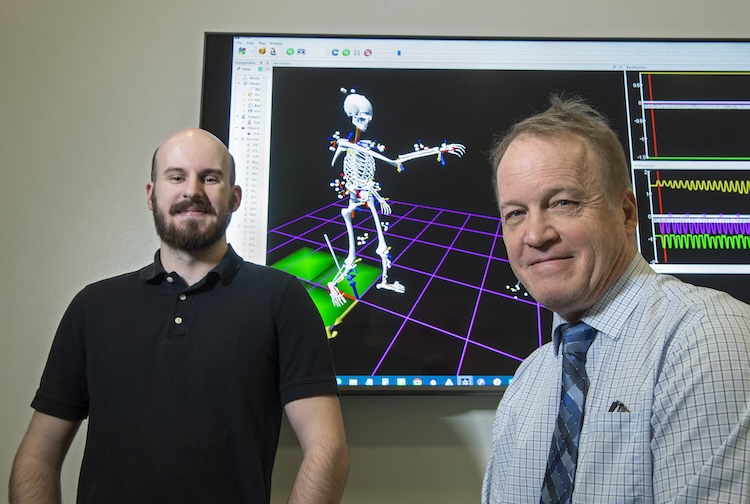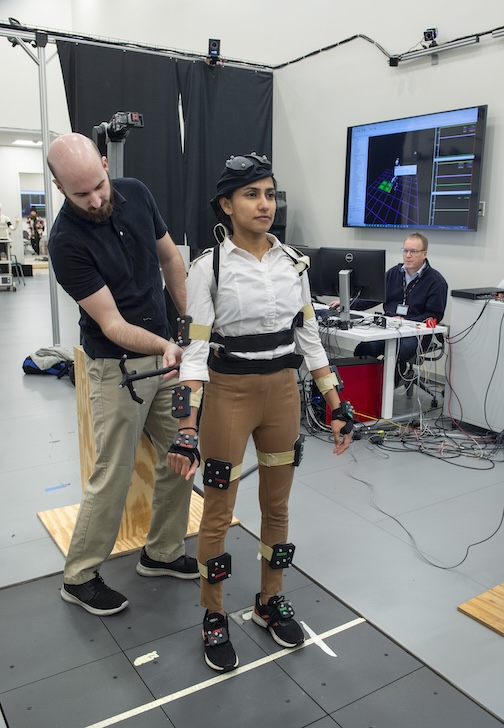Transdisciplinary project is using robotics to advance concussion recovery
A VCU research team utilizes engineering approaches to study how concussions impact hand-eye coordination.
January 16, 2024 Tanu Bhargava, a VCU student and research participant, wears a motion-capture suit as she reaches toward targets in front of a robotic arm. The exercise is part of a research project to better understand how concussions impact hand-eye coordination. (VCU Enterprise Marketing and Communications)
Tanu Bhargava, a VCU student and research participant, wears a motion-capture suit as she reaches toward targets in front of a robotic arm. The exercise is part of a research project to better understand how concussions impact hand-eye coordination. (VCU Enterprise Marketing and Communications)
By Olivia Trani
In the United States, about 1 in 4 people are estimated to sustain a concussion in their lifetime. Some people who have a concussion fully recover in a matter of days, while others still experience symptoms for several weeks, months, or even years following their injury.
A team of researchers at the Virginia Commonwealth University College of Health Professions and College of Engineering are using robotic technology to better understand the long-term impacts that concussions can have on patients. The goal of the project is to develop a model for assessing the level of physical impairment caused by a concussion and how long it takes to recover.
“From a therapeutic perspective, we hope that this technology can help healthcare professionals more accurately assess how quickly their patients are recovering from concussions,” said Zach Moore, a master's student in the College of Engineering's Department of Biomedical Engineering who is conducting this research as the basis for his thesis. “Collecting numerical data on a person's recovery gives the opportunity to better determine which treatments are effective for a patient."

Peter Pidcoe, P.T., D.P.T., Ph.D., and graduate student Zach Moore are using robotic technology to research the long-term impacts of concussions. (Left to right: Zach Moore and Peter Pidcoe) (VCU Enterprise Marketing and Communications)
Rehabilitation through robotics
A concussion can occur after a person experiences some form of trauma to the head, such as a bump, blow or jolt. Symptoms vary depending on the severity of the injury, but people commonly experience issues with their vestibulo-ocular reflex. This reflex stabilizes a person's gaze by moving the eye in the opposite direction to where the head moves. Disruption of this reflex can result in movement-related dizziness, blurry vision, and difficulty maintaining balance.
“If you are focusing on a distant object and then move your head ten degrees to your left, your eyes automatically will move ten degrees in the opposite direction. This reflex keeps the object visually stable. When this reflex isn't functioning properly, people often feel a sense of motion sickness and have degraded hand-eye coordination,” said Peter Pidcoe, PT, DPT, Ph.D., a professor at the College of Health Professions' Department of Physical Therapy and Moore's research advisor.
For this project, Moore and Pidcoe developed a robotic arm to help measure impairments to the vestibulo-ocular reflex in individuals who have sustained concussions at some point in their lives. Moore wrote the software that drives the robot based on algorithms provided by Pidcoe.
For this study, research participants are instructed to reach for a red square “target” on the tip of the robotic arm, kind of like giving the robot a high-five. The robotic arm is programmed to position this target at various static locations in front of participants.
“The robot is programmed to move to 27 different location points in total. Some of them are high and some are low. Some are out to your right or left,” Moore explained.
At the same time, the participants wear glasses designed to quickly switch between transparent and opaque with the release of a button. In the experiment start position, the participant places their hand on the button and the glasses become see-through, allowing them to see where the robotic arm positions the target. As soon as the participant releases their hand from the button to reach for the target, the glasses become opaque, essentially acting as a blindfold. As they reach, the robotic arm also retracts. This means the participant has to use their memory of where the target is - rather than vision or touch - to complete the activity.
During the exercise, participants wear motion capture markers and their activity is recorded on cameras. Using this footage, the researchers can reconstruct the 3D skeleton of each participant on the computer and calculate the accuracy, speed, smoothness and path of their movements as they reach for the target.
“The locations of the targets are adjusted to match the body dimensions of each participant, so that everyone has targets scaled to their height and arm length. This normalizes the data and allows a person-to-person comparison,” Pidcoe said.
The preliminary data shows that participants who have not had concussions typically get within a quarter of an inch of the target positions, while people who previously have had a concussion don't have the same accuracy. The researchers hope to gain even more insights as they enroll more participants and collect more data for the study.
“We hope to not only capture data on how accurate people are when they reach for the targets, but also how long the process takes with each movement,” Pidcoe said. “It's a simple experiment, but the data we're getting is very robust in terms of what it's telling us about how concussions influence the vestibulo-ocular reflex and hand-eye coordination.”

Zach Moore calibrates sensor points in preparation for the computer to capture research participant Tanu Bhargava's motion. (VCU Enterprise Marketing and Communications)
Transdisciplinary approach for patient impact
At the College of Health Professions, Pidcoe is the director of the Engineering and Biomechanics Lab, which is focused on identifying engineering solutions to address challenges facing patients in physical therapy. He says his work is made possible by the collaborative research culture fostered at VCU.
“One of the reasons I came to VCU was the opportunity to interlink with multiple schools,” Pidcoe said. “My background in both engineering and physical therapy has often allowed me to act as a bridge in transdisciplinary research projects.”
Pidcoe oversees several projects in his lab that utilize robotic innovations to help with physical rehabilitation. This includes using virtual reality technology as a therapeutic tool for concussion patients, developing modified elliptical exercise machines for stroke survivors, and building motorized devices to help children with movement disorders.
As a biomedical engineering master's student, Moore saw this lab as an opportunity to apply engineering principles learned from his classes to help patients improve their health.
“Biomedical engineers don't often get to interact with the patient population they are working for, and I thought this project would be a good opportunity for a more hands-on experience with direct clinical applications,” he said.
In addition to his studies and research, Moore also works at Bon Secours as a rehabilitation tech. He plans to pursue a career in developing assistive technology after graduating from VCU, but he hopes that future students continue to move this research forward.
“This thesis project is essentially laying the groundwork for others to expand upon. There are so many more factors to consider and questions to answer,” he said.




.jpg)